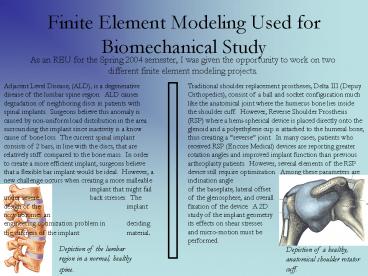Finite Element Modeling Used for Biomechanical Study PowerPoint PPT Presentation
1 / 3
Title: Finite Element Modeling Used for Biomechanical Study
1
Finite Element Modeling Used for Biomechanical
Study
As an REU for the Spring 2004 semester, I was
given the opportunity to work on two different
finite element modeling projects.
Adjacent Level Disease, (ALD), is a degenerative
disease of the lumbar spine region. ALD causes
degradation of neighboring discs in patients with
spinal implants. Surgeons believe this anomaly
is caused by non-uniform load distribution in the
area surrounding the implant since inactivity is
a know cause of bone loss. The current spinal
implant consists of 2 bars, in line with the
discs, that are relatively stiff compared to the
bone mass. In order to create a more efficient
implant, surgeons believe that a flexible bar
implant would be ideal. However, a new challenge
occurs when creating a more malleable
implant that might fail under severe
back stresses. The design of the
implant now becomes an engineering
optimization problem in deciding the
stiffness of the implant material.
Traditional shoulder replacement prostheses,
Delta III (Depuy Orthopedics), consist of a ball
and socket configuration much like the anatomical
joint where the humerus bone lies inside the
shoulder cuff. However, Reverse Shoulder
Prosthesis (RSP) where a hemi-spherical device is
placed directly onto the glenoid and a
polyethylene cup is attached to the humeral bone,
thus creating a reverse joint. In many cases,
patients who received RSP (Encore Medical)
devices are reporting greater rotation angles and
improved implant function than previous
arthroplasty patients. However, several elements
of the RSP device still require optimization.
Among these parameters are inclination angle of
the baseplate, lateral offset of the glenosphere,
and overall fixation of the device. A 2D study
of the implant geometry its effects on shear
stresses and micro-motion must be performed.
Depiction of the lumbar region in a normal,
healthy spine.
Depiction of a healthy, anatomical shoulder
rotator cuff.
2
Investigation of the Lumbar Region
As shown in the X-ray, the geometry of the lumbar
region of the spine is not only complex in the
shape of each disc but in the curvature in an
upright position. This geometry is studied using
CT scans and in some cases, cadaver sections.
A depiction of two spinal discs shows the variety
of materials present in the region. Each
material must be investigated for elasticity,
range of motion, and compressive and tensile
strength.
The movie above shows a normal spine modeled
using finite elements and a CAD program called
ABAQUS, performing movements it would see under
normal daily circumstances. With the material
properties of the bones, and ligaments, the
forces in the region are calculated and the
stress distribution is shown by the color
changes. The key in the corner of the movie
gives the stress values.
Results After creating an accurate model of a
normal spine, the same model was then modified by
adding steel bars such as those previously
implanted in patients. Next, flexible bar
implants were input into another spin model.
Both models were then investigated under normal
daily movement such as that in the movie.
Results showed that the flexible-bar implant
distributed the stress more uniformly throughout
the lumbar region. Further investigation is
expected to show greater mobility for the patient
along with longer implant life.
3
Shoulder Prosthesis Study
A model of both the Delta III and RSP device were
created in order to compare the micromotion of
each device and its dependency on the lateral
offset and inclination angle of the base-plate.
Material Properties of the joint elements
Delta III RSP
Both models were then investigated between 0 and
71 degrees abduction angles for relative motion
along the base plate.
Depiction of the base plate micromotion
The RSP device showed significantly less motion
along the base of the device when subjected to
humeral rotation. This result shows that bony
ingrowth around the device is more likely to
occur, possibly increasing implant function and
life of the prosthesis. Further investigation
should show that the optimum angle for the RSP
device is between 9 and 15 degrees of
inclination. A three-dimensional study of the
device is in progress to determine the optimal
fixation and lateral offset characteristics for
the device.

